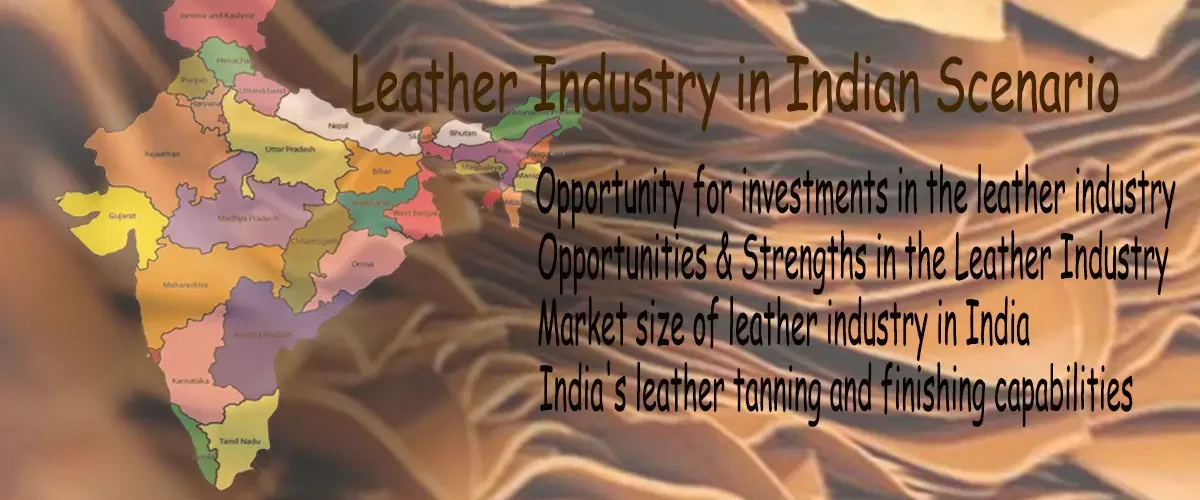Leather Industry in Indian Scenario in 2024

Welcome Readers in the blog post of ‘Leather Industry in Indian Scenario in 2024’. In this blog post we are going to explore about Leather, Role of leather industries in the growth of Indian economy, Strengths & Opportunities in leather Industry. Now it’s time to Spearheading Indian leather philosophy. Keep in mind that the leather industry’s vast potential for employment, growth and exports makes it a source of livelihood for many people in India. It empowers them economically especially by providing employment to the weaker sections of the society. With an annual turnover of $7 billion, exports of leather and leather products have grown manifold in the last decade. The sector is known for its consistency in high export earnings and is one of the country’s top ten foreign exchange earners.
What is leather?
By tanning process of animal skin and rawhide, primarily cattle hide, leather is a strong and flexible material.
Among the all industries one of the oldest traditional industries is the leather industry. It significantly contributes to economic expansion, regional development that is balanced, job creation, and overall poverty reduction. Due to its significant export earnings, potential for job growth, and favorable conditions for long-term expansion, the leather sector has played a significant role in the development of our economy.
Opportunities & Strengths in the Leather Industry
India’s from ancient day’s supply of raw materials for the leather industry to world.
Hides come from live stock like cattle, buffaloes, goats and sheep that are high valued in leather manufacturing industry.
The industry is provided with a wealth of raw materials as India is endowed with 20% of the world’s cattle and buffalo and 11% of the world’s goat and sheep population.
Market size of leather industry in India
Nearby by 12.9% of the world leather production of hides or skins comes from India.
India has access to 20% of the world’s cattle and buffalo population as well as 11% of the goat and sheep population, providing an abundance of raw materials.
Indian synthetic (artificial) leather made of polyurethane (PU)
Market size for polyurethane (PU) synthetic (artificial) leather in India was estimated at $3.97 billion.
Youth power: 55% of the workforce is under 35 years old.
Market benefit: A doubling of the domestic market for fashion accessories
High potential for export growth, capacity modernization, and a welcoming investment environment
Favorable government support – Helping Indian states develop their export infrastructure. Indian state governmental initiatives policy of fulfill with necessary infrastructure in the form of Mega Clusters. Indian states have the ability to handle large projects and incorporate new technologies.
India’s leather tanning and finishing capabilities
With 1192 million pieces of hides and skins that can be processed through tanning and finishing annually distributed across the nation. The Indian government has permitted the duty-free import of hides and skins from anywhere in the world in order to increase the supply of raw materials available domestically. Any foreign manufacturer looking to move their production base from a high cost location to a low cost base will find it attractive. The tanning industry produces about 3 billion square feet yearly.
Due to the high demand for superior leather quality (fine finish, smoothness, and gloss), leather chemicals are widely used in the construction industry. Furthermore, leather is a fundamental component of personal protective equipment (PPE), such as gloves and shoes. These consist of substances that are essentially necessary in the initial stages of leather processing. It includes chromium sulfate, formic acid, fungicides, low sulfide unhairing agents, and aldehyde tanning agents. They are essential to the company. For instance, fungicides aid in preventing fungal growth in skin or hide and formic acid lowers the pH value of skin.
Opportunity for investments in the leather industry
The potential to boost domestic production and exports is significant. A significant portion of the Indian economy is devoted to the leather industry. This industry is among the top ten foreign exchange earners for the nation and is renowned for its consistency in producing high export earnings. The organized and unorganized sectors of the leather industry coexist in India. The small, cottage, and artisan sectors (unorganized), which produce approximately 75% of India’s leather, are unorganized.
The English and the French did, however, introduce the modern method of leather production to India in 1857. India’s leather industry has historically produced hides and skins. But there are also ancillary leather industries that produce leather shoes, leather clothing, and other leather products like women’s bags, gloves, travel cases, wallets, and belts.
Export of footwear in India
The value of India’s exports of footwear, leather, and leather goods in 2020–21 was $3.68 billion. 49.23% of footwear exports are shoes. Men make up the majority of the product mix (55%) followed by women (35%) and kids (10%). There is a sizable domestic retail market with 2021 million pairs (90%), despite an annual production of 2257 million pairs.
Most of India’s contemporary shoe manufacturers already provide well-known brands in Europe and the United States. India is a desirable location for technology and investments due to the size of the domestic market and the possibility of serving global markets.
The future and role of the leather industry in the expansion of the Indian economy
Let’s look at how the leather industry has contributed to the expansion of the Indian economy. The leather industry in India has grown significantly, evolving from a simple supplier of raw materials to an exporter of finished goods. The second-largest producer of shoes in the world, India produces over 700 million pairs annually. Currently, the leather industry exports a total of 2.41 billion pairs, with 80% of those being finished goods with value added.
Industry of Indian Saddlers & Hardness
India is the world’s third-largest exporter of Saddler & Harness and the second-largest exporter of leather apparel. Along with bags, handbags, hand gloves, and industrial gloves, this industry also manufactures wallets, Rucksacks, folios, briefcases, travel ware, belts, sports goods, upholstery, and saddler goods.
The military and police were the main consumers of the saddlers who were established in the 19th century. According to reports, the export of saddlery and harness products has experienced a 40% annual growth rate. Germany, the United States, the United Kingdom, France, Scandinavia, the Netherlands, Japan, Australia, and New Zealand are the top importers of Indian saddler.
Major international markets for Indian leather and leather goods
The major markets for Indian Leather & Leather Products are USA – 15.70%, Germany – 11.58%, UK – 10.50%, Italy- 6.48%, France – 5.68%, Spain – 4.54%, UAE – 3.97%, Netherlands – 3.42%, Hong Kong – 3.34%, China – 2.60%, Poland – 2.02%, and Belgium – 2.00%. Together, these 12 nations account for nearly 71.84% of India’s total exports of leather, leather goods, and footwear. 54% of India’s total exports of leather and leather goods go to the European Union.
Problems in the Indian leather industry
- Numerous socioeconomic activities are involved in the production of leather and leather goods. While describing some fundamental issues relating to the leather industries in developing economies, it discusses how important the leather industry is to the growth of our economy.
- Due to the use and release of chemicals from the leather into water bodies, the increased biological oxygen demand, and the threat to the lives of people and other animals that depend on the source, the production of leather has a noticeable negative impact on the environment.
- Huge quantities of pollutants are released into the atmosphere during the transformation process. These include gases that contribute to global warming on a larger scale, like hydrogen sulfide. The global carbon footprint, which is defined as the total set of greenhouse emissions produced by an event and expressed as carbon dioxide equivalent, has increased as a result of the production of leather.
- The harmful contaminants from tannery wastewater may be removed using chemical or biological treatment followed by membrane separation. Every year, 23 billion square feet of leather worth over 77 billion dollars are produced.
- Within the leather industry, there are still a lot of innovations to be made. We should be much more mindful of how we use leather, especially since it comes from animals. This industry contributes more than 600.000 tons of solid waste to the global environment.
- Leather waste can also be turned into a marketable item. There must be many more uses for the waste, and doing so could be a lucrative business. The amount of waste in relation to the amount of leather used for production is far too high.
Conclusion
Just a few words to wrap up
Delivering beyond the Pill must begin now. India ranks second globally in the export of leather clothing, third globally in the export of saddles and harness, and fourth globally in the export of leather goods.
Textiles and tropical fibers are typically used in the production of many different types of footwear products, including slippers, casual sneakers, army boots, and sports shoes.
Companies have introduced innovative products that meet customer needs as a result of the trend toward sports as leisure or at leisure becoming more and more popular. Demand for bio-based products may rise as a result of rising environmental concerns. Opportunities to invest in the leather industry exist when strengths exist. Go on reading! I’m grateful.
You may like to read
Corporate Gifting Product Ideas
Dharavi: Slum of Mumbai Aspiration
Bhutan: Mysterious Nature and Culture
Buddhism in Business Ethics: Can teachings of Buddha that are valuable to business?
Bhutan: Call for entrepreneurs to avail the opportunity of business in 2023



